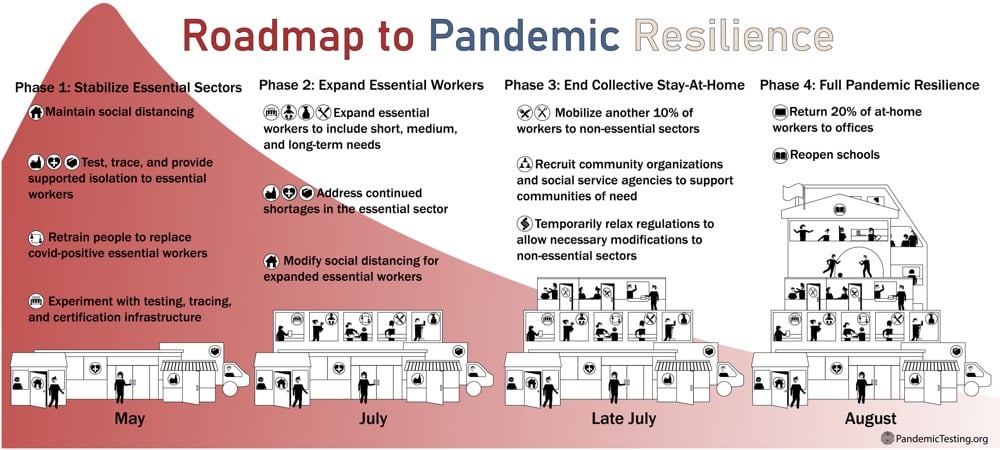How We Reopen the Country: A Roadmap to Pandemic Resilience
Working under the direction of The Edmond J. Safra Center for Ethics at Harvard University, a bipartisan group of experts in public health, economics, technology, and ethics have produced a plan for a phased reopening of public life in the United States through testing, tracing, and supported isolation. The video above summarizes the plan and here’s the full plan in the form of a 56-page PDF.
“Roadmap to Pandemic Resilience: Massive Scale Testing, Tracing, and Supported Isolation (TTSI) as the Path to Pandemic Resilience for a Free Society,” lays out how a massive scale-up of testing, paired with contact tracing and supported isolation, can rebuild trust in our personal safety and re-mobilize the U.S. economy.
Among the report’s top recommendations is the need to deliver at least 5 million tests per day by early June to help ensure a safe social opening. This number will need to increase to 20 million tests per day by mid-summer to fully re-mobilize the economy.

From the paper, here’s a quick overview:
What we need to do is much bigger than most people realize. We need to massively scale-up testing, contact tracing, isolation, and quarantine-together with providing the resources to make these possible for all individuals.
Broad and rapid access to testing is vital for disease monitoring, rapid public health response, and disease control.
We need to deliver 5 million tests per day by early June to deliver a safe social reopening. This number will need to increase over time (ideally by late July) to 20 million a day to fully remobilize the economy. We acknowledge that even this number may not be high enough to protect public health. In that considerably less likely eventuality, we will need to scale-up testing much further. By the time we know if we need to do that, we should be in a better position to know how to do it. In any situation, achieving these numbers depends on testing innovation.
Between now and August, we should phase in economic mobilization in sync with growth in our capacity to provide sustainable testing programs for mobilized sectors of the workforce.
The great value of this approach is that it will prevent cycles of opening up and shutting down. It allows us to steadily reopen the parts of the economy that have been shut down, protect our frontline workers, and contain the virus to levels where it can be effectively managed and treated until we can find a vaccine.
We can have bottom-up innovation and participation and top-down direction and protection at the same time; that is what our federal system is designed for.
This policy roadmap lays out how massive testing plus contact tracing plus social isolation with strong social supports, or TTSI, can rebuild trust in our personal safety and the safety of those we love. This will in turn support a renewal of mobility and mobilization of the economy. This paper is designed to educate the American public about what is emerging as a consensus national strategy.
The plan seems consistent with what economist Paul Romer has been saying — Without More Tests, America Can’t Reopen (And to make matters worse, we’re testing the wrong people) — and with the approach Hong Kong has been taking — Test and trace: lessons from Hong Kong on avoiding a coronavirus lockdown. See also the 4 plans to end social distancing, explained.
Unfortunately for this plan and for all of us, I have a feeling that the first true step in any rational plan to reopen the United States without unnecessary death and/or massive economic disruption that lasts for years is the removal of Donald Trump from office (and possibly also the end of the Republican-controlled Senate). Barring that, the ineffectual circus continues. (via @riondotnu)





Stay Connected